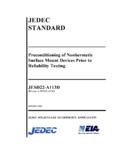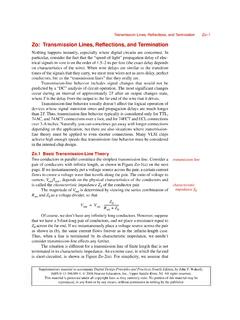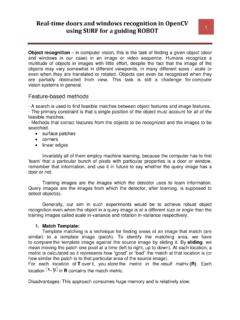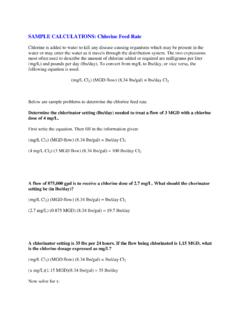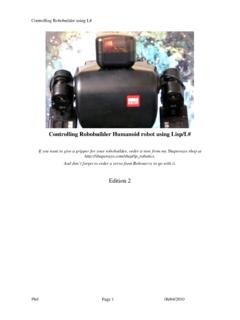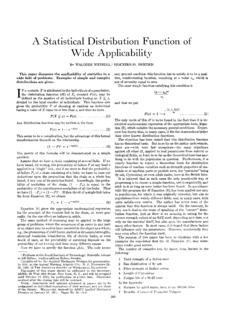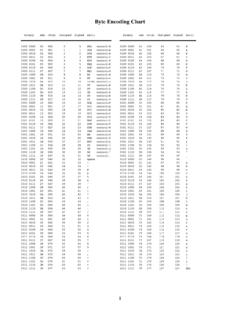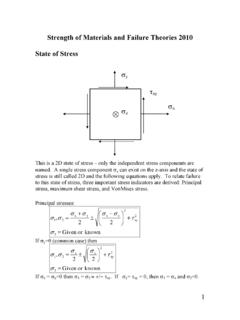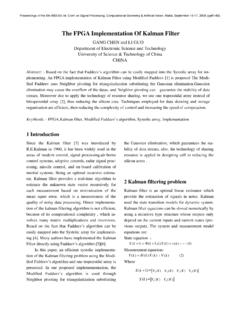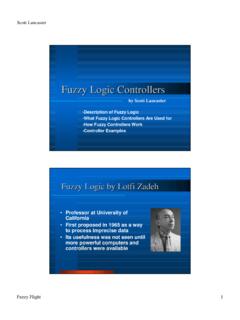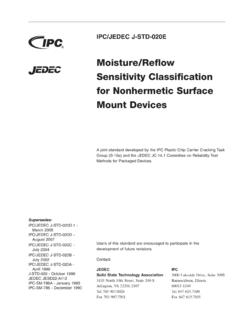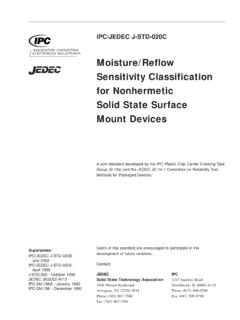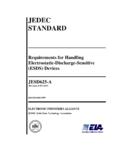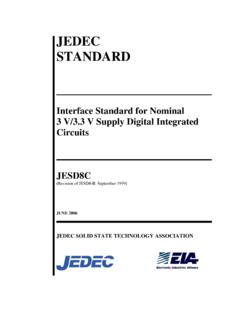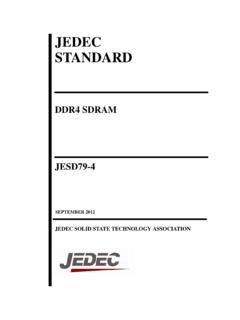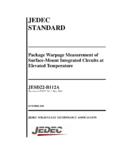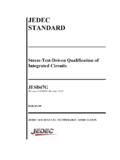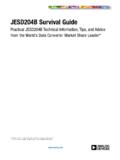Transcription of JEDEC PUBLICATION - Creating Web Pages in your …
1 JEDEC PUBLICATION Failure Mechanisms and Models for Semiconductor Devices JEP122E (Revision of JEP122D, October 2008) Originaly published as MARCH 2009 JEDEC SOLID STATE TECHNOLOGY ASSOCIATION NOTICE JEDEC standards and publications contain material that has been prepared, reviewed, and approved through the JEDEC Board of Directors level and subsequently reviewed and approved by the JEDEC legal counsel. JEDEC standards and publications are designed to serve the public interest through eliminating misunderstandings between manufacturers and purchasers, facilitating interchangeability and improvement of products, and assisting the purchaser in selecting and obtaining with minimum delay the proper product for use by those other than JEDEC members, whether the standard is to be used either domestically or internationally.
2 JEDEC standards and publications are adopted without regard to whether or not their adoption may involve patents or articles, materials, or processes. By such action JEDEC does not assume any liability to any patent owner, nor does it assume any obligation whatever to parties adopting the JEDEC standards or publications. The information included in JEDEC standards and publications represents a sound approach to product specification and application, principally from the solid state device manufacturer viewpoint. Within the JEDEC organization there are procedures whereby a JEDEC standard or PUBLICATION may be further processed and ultimately become an ANSI standard.
3 No claims to be in conformance with this standard may be made unless all requirements stated in the standard are met. Inquiries, comments, and suggestions relative to the content of this JEDEC standard or PUBLICATION should be addressed to JEDEC at the address below, or call (703) 907-7559 or Published by JEDEC Solid State Technology Association 2009 3103 North 10th Street Suite 240 South Arlington, VA 22201-2107 This document may be downloaded free of charge; however JEDEC retains the copyright on this material. By downloading this file the individual agrees not to charge for or resell the resulting material.
4 PRICE: Please refer to the current Catalog of JEDEC Engineering Standards and Publications online at Printed in the All rights reserved PLEASE! DON T VIOLATE THE LAW! This document is copyrighted by JEDEC and may not be reproduced without permission. Organizations may obtain permission to reproduce a limited number of copies through entering into a license agreement. For information, contact: JEDEC Solid State Technology Association 3103 North 10th Street Suite 240 South Arlington, VA 22201-2107 or call (703) 907-7559 JEDEC PUBLICATION No. 122E -i- FAILURE MECHANISMS AND MODELS FOR SEMICONDUCTOR DEVICES Contents Page Foreword iii Introduction iii 1 Scope 1 2 Terms and definitions 1 3 Inclusions, deliberate omissions, and resources 4 4 The basic thermal acceleration equation 7 5 Models for common failure mechanisms 7 FEoL Failure Mechanisms Time-Dependent Dielectric Breakdown (TDDB) gate oxide 7 Hot Carrier Injection (HCI) 12 Negative Bias Temperature Instability (NBTI) 14 Surface inversion (mobile ions)
5 17 Floating-Gate Nonvolatile Memory Data Retention 19 Localized Charge Trapping Nonvolatile Memory Data Retention 21 BEoL Failure Mechanisms Time-Dependent Dielectric Breakdown (TDDB) ILD/Low-k/Mobile Cu ion 24 Aluminum Electromigration (Al EM) 31 Copper Electromigration (Cu EM) 34 Aluminum and Copper Corrosion 37 Aluminum Stress Migration (Al SM) 41 Copper Stress Migration (Cu SM) 43 Packaging/Interfacial Failure Mechanisms Fatigue failure due to temperature cycling and thermal shock 46 Interfacial failure due to temperature cycling and thermal shock 50 Intermetallic and oxidation failure due to high temperature 53 Statistics and Modeling Parameter Determination Reliability data/analysis 55 Design of Experiments (DOE) for determination of modeling parameters 60 6 Activation energies and modeling factors 62 Annexes Annex A List of references 67 Annex B Differences between JEP122E and 81 JEDEC PUBLICATION No.
6 122E -ii- FAILURE MECHANISMS AND MODELS FOR SEMICONDUCTOR DEVICES Contents Page Figures Photograph of TDDB breakdown in a gate oxide mid-gate 11 Time-Dependent Dielectric Breakdown (TDDB) in various dielectrics 24 Metal stack cross section/schematic 26 normal distribution of breakdown voltage 27 Copper short/extrusion 28 Examples of Aluminum Electromigration 34 Examples of Copper Electromigration 36 Aluminum bond pad corrosion 40 Electrochemical reaction 40 Corrosion rate versus surface mobility 40 Examples of Aluminum Stress Migration 43 Examples of Copper Stress Migration 45 Examples of temperature cycling/thermal shock damage 49 Example of interfacial delamination after temperature cycling 52 Lognormal Distribution 57
7 Weibull Distribution 57 Tracking of lognormal and Weibull distributions 58 Lognormal plotted as Weibull 59 Weibull plotted as lognormal 59 Tables Values for q for common ULSI material classes 47 Values for the Paris Law exponent, m for several different interfacial fracture mechanisms 51 Example for temperature cycle schedule 61 Failure Mechanisms and Model Parameters 63 JEDEC PUBLICATION No. 122E -iii- FAILURE MECHANISMS AND MODELS FOR SEMICONDUCTOR DEVICES Foreword This PUBLICATION provides guidance in the selection of reliability modeling parameters, namely functional form, apparent thermal activation energy values and sensitivity to stresses such as power supply voltage, substrate current, current density, gate voltage, relative humidity, temperature cycling range, mobile ion concentration, etc.
8 The failure mechanisms described in the several sections of JEP122D constitute commonly accepted industrial models, validated by a team of reliability experts (SEMATECH/ISMI Reliability Council) and buttressed by citations to the most cogent published literature. Revisions have been made to reflect technology changes, especially as Cu now supplements Al and low dielectric constant insulators are complementing traditional silica. Introduction Accelerated tests are typically used to find and identify potential failure mechanisms in semiconductor devices and to estimate the rate of their occurrence in electronic systems.
9 The historical approach to investigating the relationship between a maximum stress failure rate and a system failure rate is to choose a single representative "equivalent" thermal activation energy for a given product or product group. A single, best-estimate activation energy value facilitates accurate estimation of the acceleration factor for the device failure rate estimation in the system application. While that approach has been generally accepted by the industry because of its simplicity and direct relationship to products, another method has been developed, the Sum-of-the-Failure-Rates method, that offer more information of why devices fail.
10 A word about formats within this document: parentheses ( ) enclose equation numbers; square brackets [ ] enclose citation numbers. All equation, citation, and figure numbers include the subclause number so that individual clauses can be modified without disturbing other clauses, except for page numbers. Thus, ( ) is the 2nd equation in subclause and [ ] is the 5th citation in subclause The citations can be found in Annex A. JEDEC PUBLICATION No. 122E -iv- JEDEC PUBLICATION No. 122E Page 1 FAILURE MECHANISMS AND MODELS FOR SEMICONDUCTOR DEVICES (From JEDEC Board Ballot JCB-01-97, JCB-03-39, JCB-08-61, and JCB-09-19 formulated under the cognizance of Subcommittee on Reliability Test Methods for Packaged Devices.)
